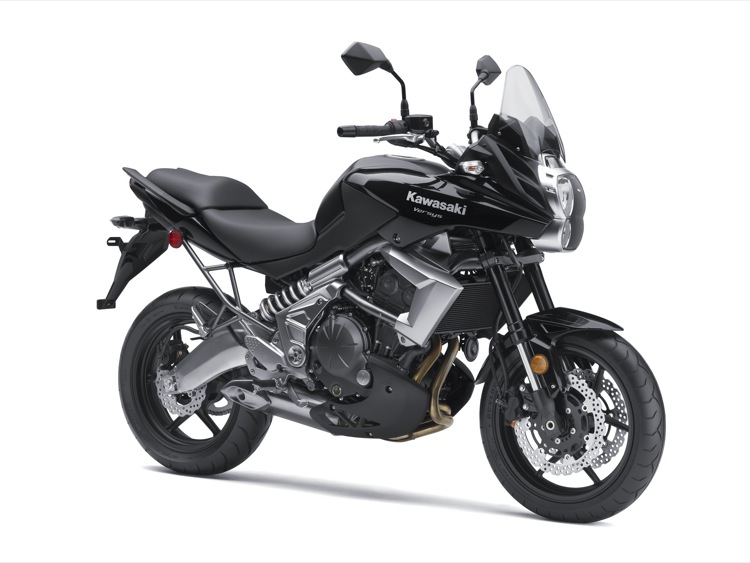Kawasaki's 2010 Lineup

Kawasaki recently invited RoadRUNNER to attend a two-day ride highlighting the light side of their model lineup. Austere times and higher gas prices have given pause to the gluttony of just a couple years ago, when all the attention was on huge, heavy models. For two great days we rode a variety of Kawi's affordable 2010 mid-size models in sunny southern California.
Day One - a World of Curves
The first day we rode the famous Ortega Highway from the coast to Lake Elsinore, then on to Temecula, Aguanga, Hemet, and Idyllwild on wonderfully curvy mountain roads where we could really put the street bikes through their paces. We sampled the Versys, Ninja 650R and ER-6n, which all share the same drivetrain. Their compact liquid-cooled, 649cc parallel-twin is a double overhead cam (DOHC) design with four valves per cylinder. It has a balancer shaft designed to reduce engine vibration and fuel injection for efficiency. A multi-plate cable-actuated, wet clutch connects the engine to the slick-shifting six-speed gearbox and an O-ring chain completes the drivetrain. With all three models, the peppy engines are a joy to use, they shift smoothly and get good gas mileage, yet they also differ significantly.

Versys
The Versys is more popular with older, more-experienced riders, for touring as well as commuting and zipping around town. For 2010, the new Versys gets a number of upgrades designed to make it even more practical and fun to ride. Styling changes include a new taller three-way adjustable windscreen. Improved vibration damping and upgraded passenger accommodations enhance long-distance riding and two-up comfort, while revised mirrors, new tie-down hooks, and other detail upgrades make it better equipped for long trips. The Versys was already a nimble, comfortable bike with good handling, and with the changes it's even better. Suggested retail is $ 7,599.
Ninja 650R
Kawi's research shows that the Ninja 650R and ER are mostly used for commuting and around-town riding by younger riders with limited experience. Additionally, these two models have lower seat heights, which appeal to many newbies and folks of shorter stature.
Fun in the canyons and respectable on the straights, this twin-cylinder Ninja uses a steel-trellis chassis and an innovative side-mounted single rear shock with the shared 649cc powerplant. The bike's slim form is wrapped with a full fairing, and sport-tuned suspension, triple disc brakes, and a curb weight of 450 pounds give this machine the sporty performance and handling you expect from a Ninja. With a 31.1-inch seat height, it accommodates medium-height riders, and the riding position is more relaxed than most sportbikes. Suggested retail is $ 7,099.

ER-6n
The naked ER-6n shares the basic underpinnings with the Ninja 650R, but leaves that rev-happy 650 twin out in the open where you can see it. The ER-6n does have a small fly screen around its headlight, but this one's for riders who like being in the wind; it's particularly good where the weather's hot. Otherwise, the ER-6n carries all the hardware and offers handling similar to its Ninja 650R brethren. And deleting the fairings also brings the price and insurance down substantially; the MSRP is $ 6,699.
Day Two - Off Pavement
When the pavement ends, the fun doesn't have to stop if you're riding a dual sport! For our second day, we rode on hilly dirt roads southwest of Idyllwild, with a nice mix of terrain and conditions. We split our time between the KLR650, the top selling dual sport bike in America, and the KLX250S, America's second-best selling dual sport machine.

KLR650
The KLR is a tall "trailie" with a 35-inch seat height and plush long-travel suspension that is at home on both dirt roads and Interstates. Powered by a liquid-cooled 651cc single-cylinder DOHC four-valve engine, it runs on regular gas and can go a long way on its 6.1 gallons of fuel. We really like the overall abilities of this venerable model that was updated for 2008, and while a bit heavy, it's particularly good if you typically travel a combination of dirt, gravel, and paved roads, and highways. Suggested retail for the KLR650 is $ 5,999.
KLX250S
For power, an electric start, liquid-cooled 249cc single-cylinder engine teams up with a six-speed gearbox. A 34mm semi-flat slide Keihin CVK carburetor provides good throttle response and a broad power band. Warm or not, it fires right up, runs strongly, and a gear-driven balancer keeps it smooth. The KLX250S now meets strict CARB regulations, so it's available in California. Kawi claims 70 mpg, but the 2-gallon tank still seems a bit too small.

A box-section steel frame, inverted 43mm cartridge fork with adjustable compression damping and a single rear shock with aluminum swingarm do a nice job of soaking up small to medium-sized bumps, but the front end dives considerably on the street under braking. Both the 21-inch front and 18-inch rear wheels were beefed up with thicker spokes, and the tires have a tread pattern that provides respectable off-road capability and a safe, stable ride on pavement.
The low center-of-gravity and light weight make maneuvering on tight trails much easier. While the KLX250S is significantly lighter at 298 pounds curb weight, its 10 inches of front and 9.1 inches of rear wheel travel still yield a seat height of 35 inches that rivals the bigger KLR.

The KLX250S has lights, turn signals, and all the other stuff you need to be street-legal. We found the KLX to be a first-rate dual sport motorcycle that's more at home on dirt, but with its limited power, it gives up highway prowess to the KLR. Suggested retail has been reduced from $ 5,299 to $ 4,999.
On the Lighter Side
Losing weight and living on a budget never seemed particularly appealing before. But with this selection of available machines, it looks like the fun can continue as we wait for the economy to rebound.







